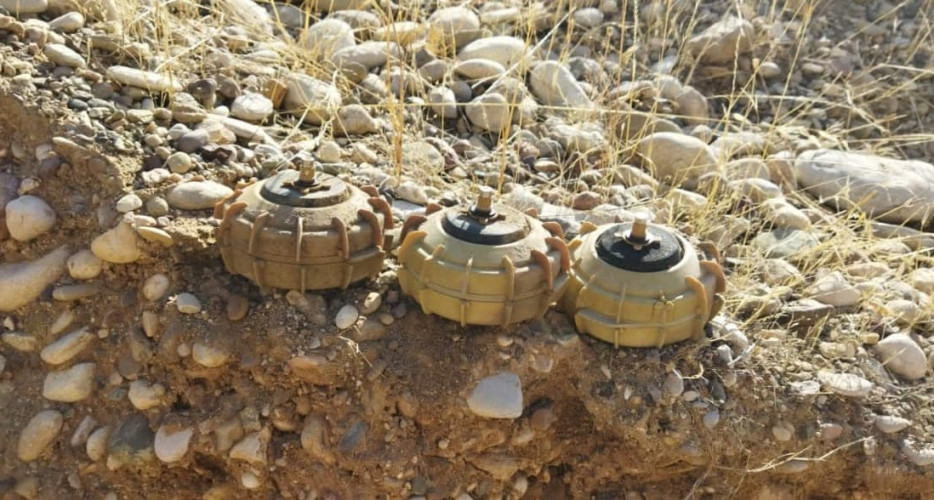'I Have Been Pierced by Mines'; The Lingering Threat of War Remnants Endangers Civilians

Peregraf- Ghamgin Muhammed
Landmines and unexploded ordnance (UXO) have twice shattered the heart of Parwin Hussein—not in times of armed conflict, but during the mundane struggle for livelihood and daily survival.
Seven years apart, Parwin lost both her sons to landmine explosions. In 2018, Salah Rafiq stepped on a mine, and this year, Saman Rafiq met the same tragic fate. Both incidents occurred in the Penjwen district of Sulaymaniyah province while the brothers were collecting scrap metal and wild herbs.
"Mines have torn through my life. I lost two sons, both married with children," Parwin Hussein told Peregraf. "This spring, Saman went with two friends to gather herbs in Penjwen. He knew the area well—it was near our home. In the evening, his leg hit a mine, and it detonated."
Penjwen, the last border district of Sulaymaniyah province adjacent to Iran, was a hotspot during the Iraq-Iran war. Like many other areas in the Kurdistan Region, it remains contaminated with thousands of landmines, posing a persistent and deadly threat to civilians.
Parwin recounted that Saman’s leg was severed by the blast, and though he managed to crawl several meters away, "his friends couldn’t reach him in time to carry him to safety. By the time we were notified late that night and rushed from Sulaymaniyah, he had already succumbed to blood loss and the cold."
Rising Casualties and Government Warnings
Landmine casualties have surged this year, with 22 victims recorded so far—eight dead and 14 injured, all civilians. Fourteen were from Sulaymaniyah, seven from Erbil, and one from Garmiyan. This marks a sharp increase from last year’s eight casualties.
Jabbar Mustafa, head of the General Directorate of Mine Action (GDMA), explained to Peregraf that all mined areas are clearly marked and designated as no-go zones, with annual re-marking efforts. "Yet, civilians ignore the warnings, risking their lives for meager earnings—scrap metal or herbs—and becoming victims."
According to the GDMA, February, April, and November are peak months for incidents, as civilians venture into restricted areas in search of resources.
Parwin Hussein now has only one surviving son. "I often told my children it was wrong to it was wrong to enter the mined and prohibited areas just to make a living,' she told Peregraf. 'No matter how much I warned them not to go, they would say, 'Mother, We know these areas like the back of my hand - our struggles shouldn't concern you."

Historically, 776 square kilometers of the Kurdistan Region were mine-contaminated. Of these, 576 sq km have been cleared, leaving 200 sq km still hazardous. 60% of the remaining contaminated land lies in Sulaymaniyah province.
Mustafa stated that clearance operations continue from Zakho to Garmiyan, but limited resources and the KRG’s financial crisis prevent full-scale work. Priority is given to areas near populated zones and tourist sites.
Landmines do not expire and can remain active for decades. Rain and floods often shift their positions, spreading contamination.
Seven years ago, Parwin received the devastating news of her elder son Salah’s death. "I didn’t know he had gone to Penjwen to collect scrap metal. That morning, I felt uneasy—restless. By evening, my brother came and told me Salah had stepped on a mine."
Initially, she was told he was hospitalized with leg injuries. "I thanked God and rushed to see him. But when the car turned toward the forensic doctor, I lost all hope. Instead of seeing him alive, I received his body."
Iraq still has over 2,100 sq km of mined land—equivalent to 300,000 football fields. According to the International Committee of the Red Cross (ICRC), 78 casualties were recorded between 2023 and 2024.
Under Iraqi law, mine victims are recognized as "Civilian Martyrs." Adel Hamasalih, spokesperson for the Ministry of Martyrs and Anfal Affairs, told Peregraf: "Any civilian killed by mines, war remnants, or ordnance from neighboring countries is considered a martyr and receives martyr benefits."
However, disabled survivors receive minimal support—a monthly stipend of less than 150,000 dinars (~$100). Peshmerga disabled in mine incidents receive higher compensation, but civilians are treated as ordinary cases.
Demining personnel also face grave dangers. GDMA reports 36 staff martyred and 78 disabled in recent years.

Mine clearance training conducted for a group of Peshmerga
Mustafa noted that protective gear meets international standards, preventing staff casualties in recent years. However, deminers remain contract workers with no special benefits. A draft law to grant them Peshmerga-level martyr and disability status has stalled in Parliament.
"We demand that the draft law on the rights and privileges of mine workers be approved, and that legal provisions be granted to recognize casualty staff of the mine clearance agency as Frontline Martyrs, while ensuring those workers who become disabled receive appropriate compensation." This constitutes the primary demand of the GDMA.
The Kurdistan Region’s 24/7 hotline (182) allows civilians to report suspicious objects or trespassing in mined areas. Awareness campaigns target high-risk villages.
Per Iraq’s Environment Ministry, over 6,000 sq km have been cleared since 2003. The country aims to be mine-free by 2028, though challenges persist.
Tearfully clutching her four-year-old grandson—the child of one of her lost sons—Parwin Hussein begged: "To the youth: Stay away. Do not enter those marked areas. Mines have burned my heart twice. I am now left with three fatherless children."